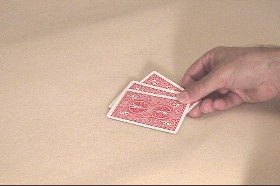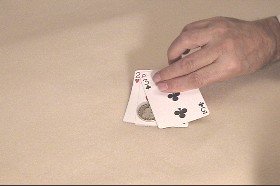| on the top card prevents the top card from moving to the right. The top card falls on top |
| of the space just occupied by the coin that is no longer there. This picture shows the |
coin held by the thumb and third finger.  |
| Mr. Spooner approached me at a convention long ago and showed me this idea for |
| accomplishing the initial transfer. It is quite brilliant. The right hand holds the stack of |
| four cards by the lower right corner of the stack. The cards are reverse spread so the |
| top card is further to the left than the other cards. The hands approach the coin at the |
| upper right position moving over the coin. The left finger presses against the top card |
| while the right hand moves to the right. Thus, the top card is slid onto the coin. The |
remaining fan is moved to the lower right coin.  As the cards are brought over As the cards are brought over |
| the coin, the fan is pressed into the table. The second card edge hits the top of the coin. |
 Then the cards are moved to the left while the edges are pressing against the Then the cards are moved to the left while the edges are pressing against the |
| coin and the table. This causes the coin to slide under the second card and above the |
| bottom card. The left finger presses against the top card and the lower cards move to |
| the right. The now hidden coin snuggles between the second and third coin. The top |
| card is slid to the tabletop. The following picture shows how the two cards hold the |
coin.  The right carries the cards and coin to the upper left position. Again, the The right carries the cards and coin to the upper left position. Again, the |
| left finger presses against the top card and slide it over the coin there. The hidden coin |
|
|     |



